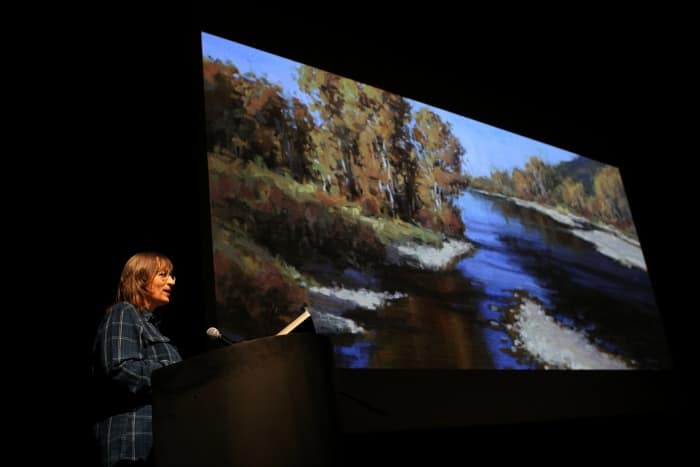Creating the Visual, Expansive World and Effects of #GoodDino with Calahan,Munier and Reisch #GoodDinoEvent
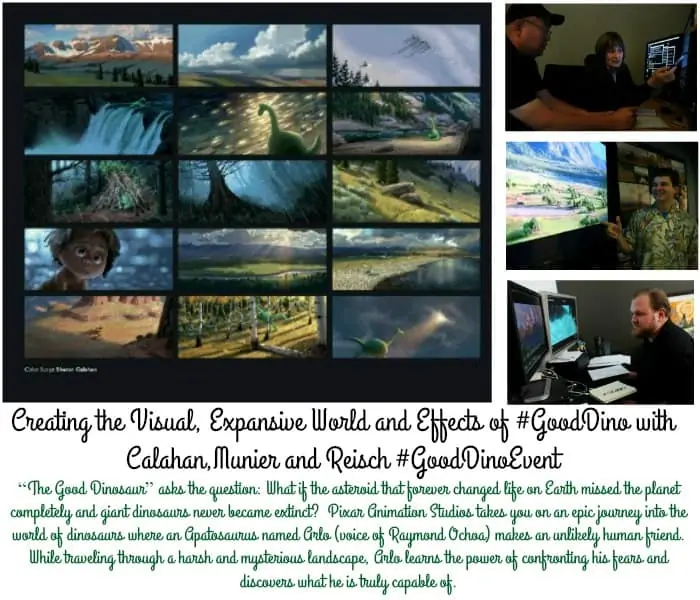
**Disney provided Me With A Full Expense Paid Trip To San Francisco For The #MilesEvent, #GoodDinoEvent, #InsideOutBloggers & #Waltagram Press Trip. No Other Compensation was Given. The Opinions In My Posts Are 100% my own.**
From the color scripts to the final picture progression presentation with Sharon Calahan(Director of Photography – Lighting) VIEW FROM ABOVE: Learn about creating the expansive world in the film with Sets Supervisor David Munier, and hear how the team used actual USGS data of the northwest United States to create the sets. EFFECTIVE STORYTELLING: Explore with Effects Supervisor Jon Reisch how the Effects team created different environments using effects to support the storytelling.
While visiting Pixar Animation, we were able to learn more about the making of The Good Dinosaur. We had the privilege to listen to Sharon Calahan (Director of Photography-Lighting), David Munier (Sets Supervisor) and Jon Reisch ( Effects Supervisor) talk about their contributions to the making of the movie.
Lighting with Sharon Calahan
Sharon Calahan talked to us about how she created the color scripts through her photography and paintings. She led us through what inspired her, as well as what inspired Peter Sohn. One of the memorable films that inspired her and Peter was The Black Stallion. ‘The Black Stallion’ had a loss, friendship, with images instead of words. This is one of the ideas that they wanted to convey while making the movie. Other movies that entered their minds were ‘Never Cry Wolf’, for its vast landscapes, scenes where the researchers were showing scope and scale. ‘7 Years in Tibet’ gave a great physical journey as well as the big emotional journey. ‘Seraphim Falls’ was the story of two characters (much like Arlo and Spot), intertwined with the wilderness landscapes and the Rocky Mountains West. Also ‘Dances with Wolves’ with the Bison crowd scenes. Finding the right location was crucial. Pioneer homesteading would show struggling in a hostile environment. This is where placing a farm at the base of a rustic mountain came into thoughts for the movie.
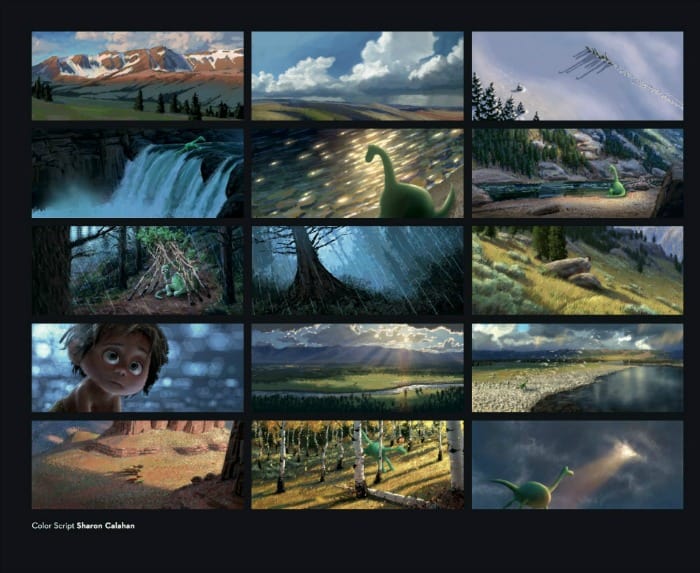
For Sharon painting in the Jackson Valley of Wyoming when they went on one of their research trips was one of her favorite places. While on their research trip they were able to ride horses through the vastness of the country. Sharon is used to the wilderness where Peter Sohn is a city ‘boy’ and it was just amazing to watch him soak in the atmosphere. She also said she could tell that Peter is one to ask as many questions as possible in order to get the feel of how he wanted the movie to be formed. Sharon enjoyed watching Pete experience things for the first time. You could see forever, you could see the milky way, how fast the weather could change. These helped him form in his mind how they would create the sets and skies.
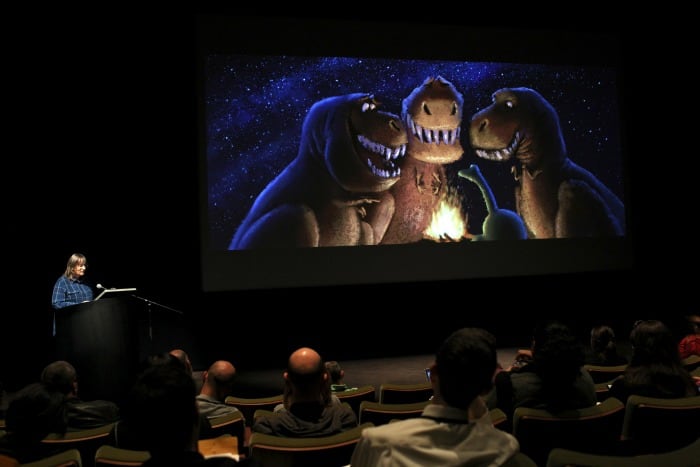
They didn’t want it to just be a farm life. But areas in all directions. It has to believably influence the whole story. Without making an imaginary world, that could happen now. They hired a tour guide company so they could go out and learn about the geology, fauna, flora, as well as taking photos of the pine needles, lichen, tree bark. Also the big horn sheep, eagles and deer. They needed to figure out the characters interacting in the world. How different situations would look like, simple single ideas. Pete was wondering what a moment would be like floating along in the river. Some of the images were used as exploration for scope, like the big sky feeling and seeing forever. Carol Ballard films inspired them which served as ‘bridges’. Pixar’s are called ‘haiku shots’, brief moments of visual poetry. Sharon’s job was to help capture the scenes of beauty in the right colors and textures to help the movie have the feel that Pete wanted it to have.
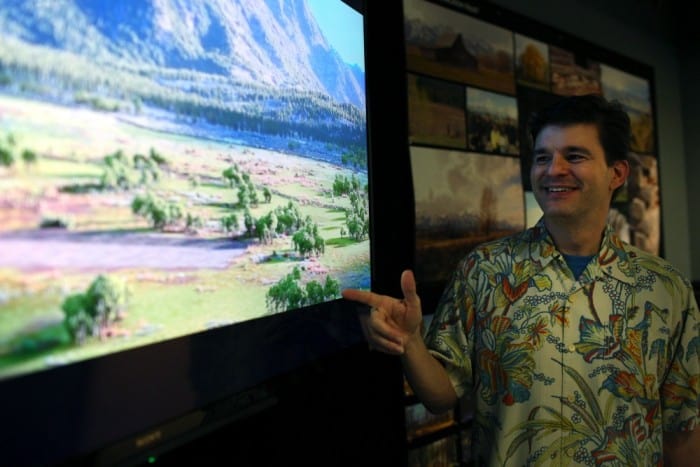
Set Director David Munier
David Munier is the Sets Director of The Good Dinosaur. His team is in charge of creating everything on the screen that is not special effects. Most of what you are seeing on screen is what the sets team build. They focus on the foreground as Pete wants to capture the beautiful cinematography. Pete wanted to be able to see 40-50 miles or so.
He wanted the lighting team to build a sense of atmosphere. A Production team would project that painting and add all of the details off in the distance. They would have to work with the production designer. Paint in all of that fog. They didn’t want to have to do that with all of the shots to get that all of the time. They used a lot of Forestry Data for height data, then had to translate it so they could look at it. They put the camera in to see how much they can recreate from the USGS (United States Geological Survey) General Topography. They also work with the art team to see how they want in order to have it look like Pete wanted it.
Just like a live-action film, they send people out to take photos for the directors to see. USGS Data gives them all types of options. They downloaded Yellowstone Park which is 13,000 square kilometers to give Pete lots of different options. Using the USGS (United States Geological Survey) was a basis for tests to do the details based on that data. For instance, the terrain of the mountains added trees and rendering the actual scale of what it might look like where they would add details.
Then they would start designing the film on top of this. The setting was the Jackson Valley otherwise known in the movie as (Clawtooth Mountain) at the base of the Tetons. They had to figure out how to make it look more like teeth and angle it a bit. They wanted to make sure the audience recognized it as the Clawtooth Mountain. They added textural details, hundreds of thousands of trees. They would make the pieces with the snow on it represent the Clawtooth Mountains. In the rest of the distance, the camera team would be able to point anywhere in the background so they knew what they were composing for the mountains. The mountains are there from the very beginning and be able to visualize all of the set for the terrain.
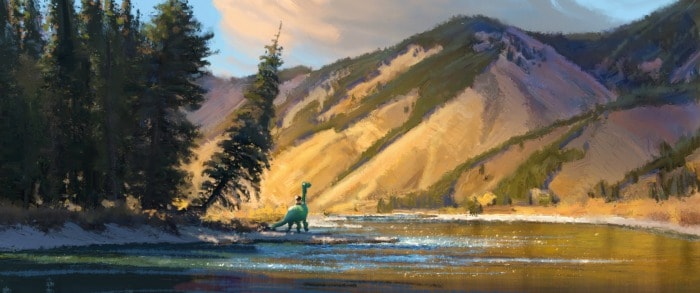
Sharon asked about the skies, so they lit the final frame of the movie to the clouds in 3D. The effects team would only do that for the storm clouds. Rest of the shots drifting, clouds paint team. They would work back and forth to figure out composition and lighting. Sharon wanted everything to be lit. To have big effect shots. They would research types of clouds, types, shapes. They would use the library of clouds in Northern Idaho. They had to do tests with the effects software when composing the clouds to make it one cohesive frame. The lighting team had full control over the lighting. They also used the Red Canyon USGS data for the effects put on the vegetation. They also would compose the shot based on the painting they got from Sharon. They could change the time of day to get the lighting that they wanted. The painter would have to change things for the time of day and have full range while doing so. Google Earth was used so they could look at the three-dimensional terrain. When Arlo was stuck on the beach and has to climb up the cliff, Pete wanted to see the terrain for miles upon miles. The terrain is so hilly they get miles and miles of depth. So they had to do more extensive testing of more trees, make Spot look tiny, and also scale Arlo to see the scale of the world, then Pete for decide. Also how it would work for lighting. Then they started designing the foregrounds, which was very interesting. From the storyboards, Arlo arrives on the beach that he has to move through the terrain. They had to embellish the foreground with pebbles, cliffs and so on.
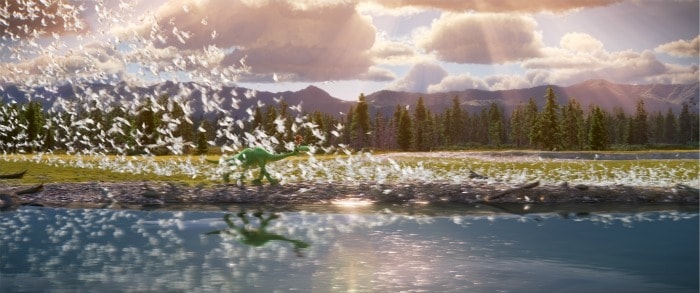
The crew also had to pull the cliffs in and make them steeper, to give textural quality with colors, rocks, bushes, and debris that had washed up on the beach. Set dresser teams had to add more trees, dozens of miles of landscape. You see Arlo exhausted walking up the hill and looking down the river to see how far he has to walk. Pete used a photo from the Grand Tetons and wanted the grassy terrain, cottonwoods, etc. The art team would go through all of the pictures to see the different vegetation. The Ponderosa Pine would look right and different enough of each other, how the cottonwoods would grow differently in groups. The winds into the tree, a still tree, wind gusts in the trees. They also had to show a calm day, scary day, how much wind to use to tell what kind of emotion tell the story. The Aspen Forrest, sagebrush and other bushes. It was important to get a sense of scale that Spot is three foot tall vs Arlo is eighteen feet tall. Like the tiny weeds, buttercups which would also tell how big Spot looked thrown off by the vegetation.
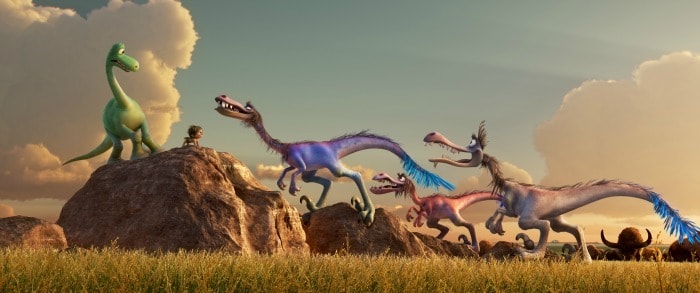
USGS survey data will change any landscapes and like in ‘Cars’ going through different areas.
Projection writers can draw on top of it. Modelers can sculpt on top of it.
If they are ok using the background terrain. Then they can. Future films that have lots of terrain use the same technology. They have used the USGS a couple of times like in Cars 2 and Mt Fuji as a basis. In UP they used it for a few scenes for modeling.
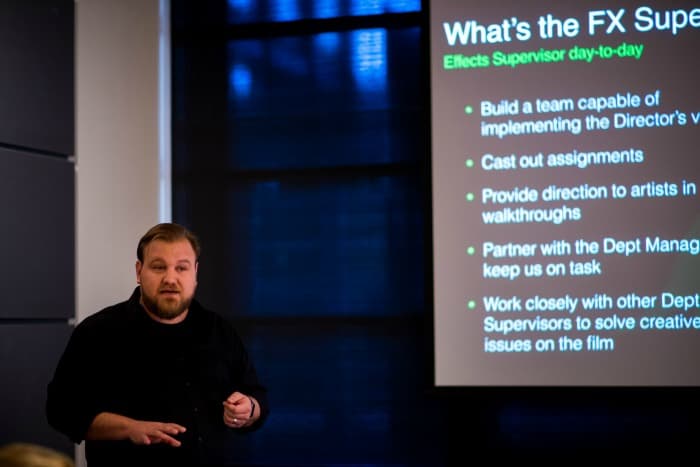
Effects Supervisor Jon Reisch
Jon Reisch is the Effects Supervisor for The Good Dinosaur. They are responsible for the rain, fire, smoke, dust, and debris. They are also in charge of the storm sequences and the huge challenge, the water. They want to provide a connection to their CG world and the CG characters. They wanted to give a sense of tangibility. They want the audience to have an emotional connection with believable interaction. They used these effects to heighten the drama, the feelings. Rain and lightning flash to heighten some of the visual characteristics.
They had 31 effects artist which is two times as many as they normally have. What makes The Good Dinosaur different for them was the journey through nature. Peter said it couldn’t feel like a walk in a park. The effects played a big role in playing in nature. They needed to make Arlo feel dwarfed even though he is 18ft tall and make him feel small. He is going to have to go miles and miles to get back, so they must show his struggle.
The story needed 900 shots, which is twice as many as normal. Their biggest challenge was the river. They were
adding a lot of Wow. Swept away is from his team. They had to show the underwater murk, the foam moving along with the right about of detail. They had to use the individual grains of sand which took huge amounts of patience in effects.
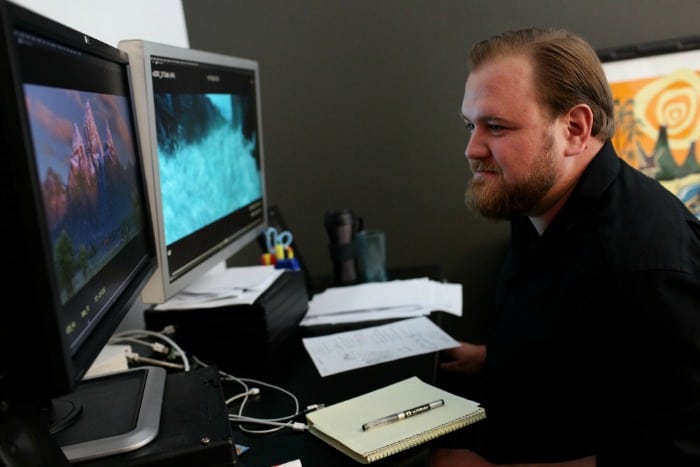
The river to shows the feelings between Arlo and Spot. Orphan Spot- the shared sense of loss. When the characters were upset more foam and churning of the river to convey this. They have done water in the past in Brave. Brave took 3o shots whereas 200 shots in The Good Dinosaur. They had to really rethink how to do this. Kind of like lego type bricks and shoot them differently. This way the audience doesn’t know they are seeing the same types of ‘prop’. They also used 300 TB on disk which is 10 times more than when they did Monsters. On-disk more than Cars 2. They had to work very closely with the systems folks. To handle the huge amount of data that was used.
Twice as big as any movie they have done at Pixar. Rethink their process, and have the technology to back it up.
Swept away from start to finish took eight months for the river itself and all of the different elements. The final shot work took another eight months. So a total of 16 months just for this area.
In order to see all of this in action, it is going to be important for you to go and see “The Good Dinosaur” which will be in theaters on November 25 (Thanksgiving) at a theater near you.
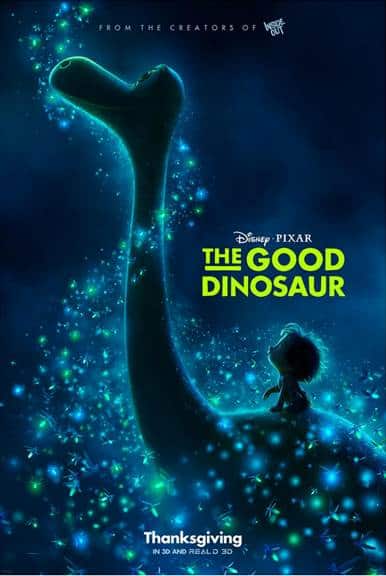 THE GOOD DINOSAUR (11/25/15)-Keep Updated on their Social Media
THE GOOD DINOSAUR (11/25/15)-Keep Updated on their Social Media
https://www.facebook.com/PixarTheGoodDinosaur
https://twitter.com/thegooddinosaur
https://instagram.com/thegooddinosaur/ (#GoodDino)
https://www.pinterest.com/disneystudios/the-good-dinosaur/
https://www.youtube.com/user/DisneyPixar
http://movies.disney.com/the-good-dinosaur
What's Your Reaction?
Newly middle-aged wife of 1, Mom of 3, Grandma of 2. A professional blogger who has lived in 3 places since losing her home to a house fire in October 2018 with her husband. Becky appreciates being self-employed which has allowed her to work from 'anywhere'. Life is better when you can laugh. As you can tell by her Facebook page where she keeps the humor memes going daily. Becky looks forward to the upcoming new year. It will be fun to see what 2020 holds.

